Keeping a Deck from Becoming a Wreck
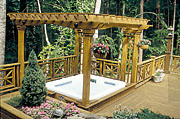 Credit: Arch Wood Protection Inc.
Credit: Arch Wood Protection Inc.
I work for a company that manufactures wood preservatives. By phone, letter, e-mail and at deck clinics, we field many questions related to the painting, staining, and sealing of preserved wood: What coatings are best? How often should I apply them? How long must I wait before painting or staining?
With the number of wood decks now exceeding 30 million in the United States and with today’s appearance-conscious but time-strapped homeowners caring more than ever about maintenance requirements, it is understandable that many questions might center on coatings. The questions are usually straightforward but, as choices in treated wood have increased, the recommendations for maintenance have become more complex.
Before addressing these questions, some preservative history and chemistry is useful.
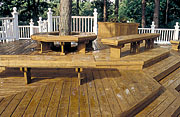 Credit: Arch Wood Protection Inc.
Credit: Arch Wood Protection Inc.The Traditional Preservatives
The pressure treatment of wood began nearly 130 years ago in response to the railroads’ need for a strong and resilient crosstie that would neither rot nor be destroyed by termites. Pressure-treated wood — wood impregnated under pressure with a liquid solution of preservative to resist damage by termites and fungal decay — filled that need economically.The original pressure preservative was creosote, a product of coal tar distillation. Creosote remains the preservative best suited for hardwood ties, and is also used for piling.
A few decades later, another industrial preservative called pentachlorophenol, or more simply penta, was introduced. It, too, remains common today, mostly for the protection of utility poles and glue-laminated structurals.
Meanwhile, development of waterborne preservatives was under way. In 1933, chromated copper arsenate (CCA) was invented. The CCA treating solution is a diluted solution of copper oxide, chromic oxide and arsenic oxide. It did not experience widespread use until the mid-1970s, at which time its use soared with the boom in suburban housing, deck construction, and do-it-yourself projects. Since then, this long-lasting, clean-to-the-touch wood has dominated the world market for residential applications.
Once a specialty building product obtained by special order, CCA-treated wood is now stocked by nearly every lumber outlet in the United States. It is the greenish colored wood found in decks, walkways, retaining walls, gazebos, playsets, docks, planter boxes, picnic tables, and a range of commercial, agricultural, industrial, and institutional uses. CCA-treated wood is sold under various brand names; the most common is Wolmanized® wood, which some people mistakenly use as a generic term.
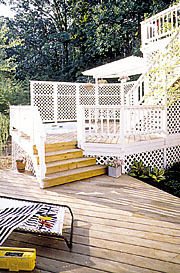 Credit: Arch Wood Protection Inc.
Credit: Arch Wood Protection Inc.The Pressure Treating Process
The production of CCA-treated wood affects the later application of coatings. Standards for proper treatment are established by the American Wood-Preservers’ Association.Lumber, plywood, poles or piling is shipped to a treating plant after being dried to remove moisture. Only certain species, principally pines and other softwoods, can be treated effectively. Drying is a necessary prerequisite because, if the pores and cells within the wood were filled with moisture, the liquid preservative solution would not have space to penetrate. This is analogous to a sponge — a dry sponge accepts water more readily than a wet sponge.
The wood is loaded into a horizontal cylinder, typically 6 feet in diameter and 80 feet long. The cylinder doorway is sealed, and an initial vacuum pulls air from voids within the wood.
At this point, the solution of CCA preservative floods the cylinder. Pressure pumps are activated, pushing preservative into the wood at about 150 psi. When the desired level of treatment is achieved, the unused liquid is pumped back into storage tanks for use in the next treatment cycle. A final vacuum removes liquid from spaces within the wood.
Upon contact, the CCA and sugars in the wood begin bonding in a chemical reaction called fixation. This reaction, which starts immediately but may take several weeks to complete if the surrounding temperature is low, makes the preservative very leach resistant.
Following removal of wood from the cylinder, sample wood borings are taken and analyzed to evaluate the amount of preservative present and its depth of penetration. Different applications require different levels of protection; for example, wood placed in the ground is subject to greater hazard than wood used above ground, and needs greater preservative protection. Wood intended for a marine piling requires 10 times more preservative than lumber that will become a fence picket.
Properly impregnated, the preservative protects wood against termites and fungal decay for decades. Many manufacturers offer a warranty that extends for the lifetime of the purchaser. No further application of any preservative is necessary to maintain this protection (with an exception covered below for western species).
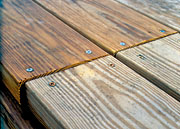 Credit: Arch Wood Protection Inc.
Credit: Arch Wood Protection Inc.The Need for Coating
There are at least three situations for which a coating is recommended.Moisture Protection
Although the preservative is quite effective against wood-destroying organisms, it has little effect on damage caused by moisture.
Wood is a natural, porous material. When it gets wet, it swells. As it dries out, it shrinks. This dimensional change presents some construction issues, but also exacts a cosmetic toll on the wood. To relieve stresses within, wood can warp (twist, bow, cup, crook), it can check (crack or split), and the grain can rise above intra-ring wood. Except in the most severe cases, these tendencies do not affect the structural strength of wood members. However, they do affect the appearance.
Where beauty is deemed important — such as decking and a deck railing — regular application of a water repellent solution is recommended. It doesn’t matter that a deck is structurally sturdy for 50 years if its owner becomes unhappy with its appearance after 10. Water repellent coating is not crucial for concealed components, such as deck joists, or applications where a weathered appearance is satisfactory, such as retaining walls.
Water repellents are sometimes called “sealers,” although they do not provide an impenetrable barrier. Instead, they slow down the rate at which moisture is absorbed and released, thus reducing stresses in wood. They lessen moisture effects; they do not eliminate them.
Color
Some property owners want their wood to match the color of their house. Or to contrast with it.
Pressure-treated wood can be painted or stained like ordinary wood. However, since the wood was saturated with liquid in the treating process, use of a film-forming coating may require a delay while the wood dries out (see sidebar).
Some stains also contain water repellent as well as pigment or dye; other coatings may include UV inhibitors or wood preservative. Machining of Western Species The species used for treated wood in western states (primarily hem-fir, western hemlock, Douglas fir) do not accept CCA preservative treatment as readily as eastern species (southern pine, red pine, Ponderosa pine). The preservative does not penetrate as deeply. Therefore, when ends of lumber are sawn or when holes are drilled into the wood, unprotected areas are exposed to fungi and termites.
To prevent premature deterioration, exposed surfaces should be brushed with or dipped into an appropriate topical wood preservative, sometimes labeled “end cut solution,” containing at least 2% copper.
Suitable products for moisture protection, coloring, and end cut treating are available at nearly all lumber outlets.
Recent Developments, New Complications
As in most other areas, competition has propelled the development of newer products and processes. The science of wood treatment has progressed. Treated wood, even CCA-treated wood, is no longer one product.Some treated wood is re-dried after treatment, either in a kiln (and marked KDAT) or in the air (ADAT), under controlled conditions. This step removes most of the moisture that was put back into the wood during the saturation of the treating process. Among other features, re-dried material is less likely to warp, as may occur when typical treated wood dries out unevenly under the sun.
Another method being used in some products to minimize warping is the addition of water repellent into the treating solution. Water repellent treated lumber has built-in protection against moisture damage, but it rejects certain coatings as well as rain.
Some treated products, notably decking in the Pacific Northwest, are pre-stained with a stain or dye before treatment or run through a stain machine after treatment. The solutions used may affect the application of other coatings.
On top of this, coatings offer a number of choices. Recommendations vary between film-forming paints and penetrating stains, and between oil- and waterborne formulations. These product choices and wood/coating combinations require different application instructions.
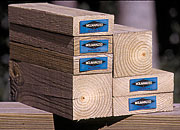 Credit: Arch Wood Protection Inc.
Credit: Arch Wood Protection Inc.Coatings and Woods
Proper coating depends on the type of treated wood. The following is not a complete guide and, as a good lawyer would advise, always follow the recommendations provided by the manufacturer of the coating.Typical Treated Wood
This is the wood most commonly sold today. The wood is still somewhat damp when purchased.
- Paint. Do not apply paint until the wood is dry, both on the surface and internally. Otherwise, as the wood dries out, escaping moisture will cause blisters and poor adhesion in the paint. Once the wood is dry, the procedure for painting treated wood is no different from that for painting untreated wood. (We don’t recommend using paint on deck flooring because frequently used pathways, such as from the steps to the door, will become worn.)
- Stain. Some stains are heavily pigmented and form a film, just as paint does. The recommendations for their application are the same as those for paint, including our advice against using them for the floor of a deck. Most stains, however, are more transparent and do not block moisture movement. There are other differences, though. Stains may be oil-based or water-based. Some formulations can be used immediately; others perform best when the wood is allowed to dry for a while. Best advice: follow the stain manufacturer’s instructions.
- Water repellent. Most brands say that it is okay to apply a water repellent without delay, which is ideal timing. For other brands, a slight delay is recommended. Again, it is best to follow the manufacturer’s instructions.
Treated Wood with Built-In Water Repellent
To protect against moisture damage, some brands of treated wood have water repellent in them as well as preservative. Thompsonized® Wood and Wolmanized® Extra® lumber are the best known examples.
- Paint, Stain. The recommendations are the same as above, but it may take longer for the wood to dry out. Therefore, the delay may be longer. For instance, Sherwin-Williams recommends waiting 30 days before applying one of their oil-based products to Thompsonized Wood, and waiting a year before using a waterborne stain.
- Water repellent. With water repellent treated wood, an initial coating of topical water repellent is not necessary. For Wolmanized Extra lumber, you don’t need water repellent for a year, and then you should reapply it annually thereafter. For Thompsonized Wood, a coating is not needed for two years and then should be reapplied every two years.
Treated Wood that is Re-Dried after Treatment
In some areas you can buy treated wood that is Kiln Dried After Treatment (KDAT) or Air Dried After Treatment (ADAT). In these processes, moisture is removed from the wood before shipment to a lumber dealer. KDAT or ADAT will be marked on each piece of wood on either the end tag or an ink stamp.
- Paint, Stain, Water repellent. The moisture content of the wood is already in balance with atmospheric moisture levels, so coating can proceed immediately.
For more information on wood finishing, contact Arch Wood Protection Inc., 1955 Lake Park Drive, Suite 250, Smyrna, GA 30080; phone 770/801.6600; fax 770/801.1990; visit www. wolmanizedwood.com; e-mail info@wolmanized.com.
Looking for a reprint of this article?
From high-res PDFs to custom plaques, order your copy today!






